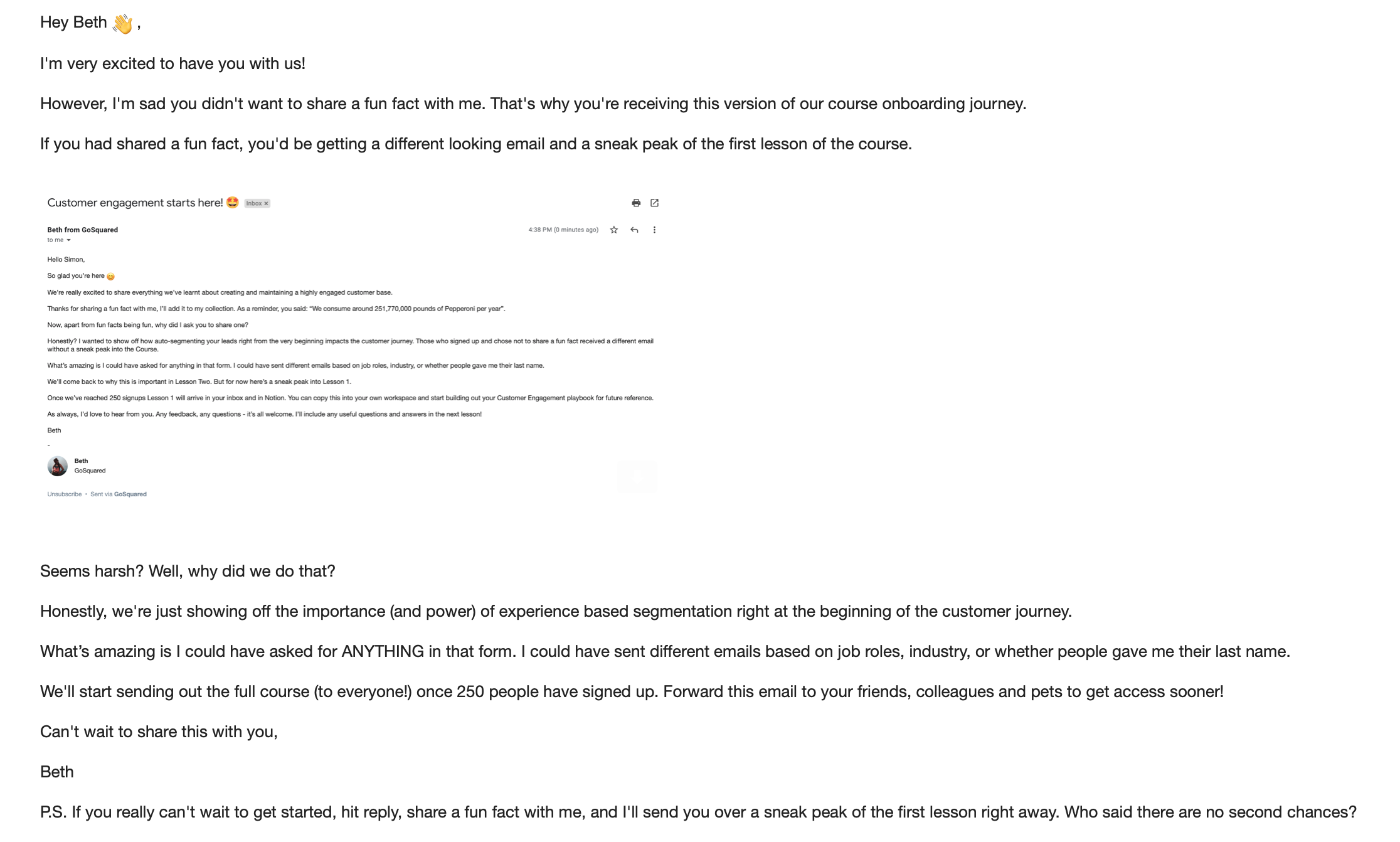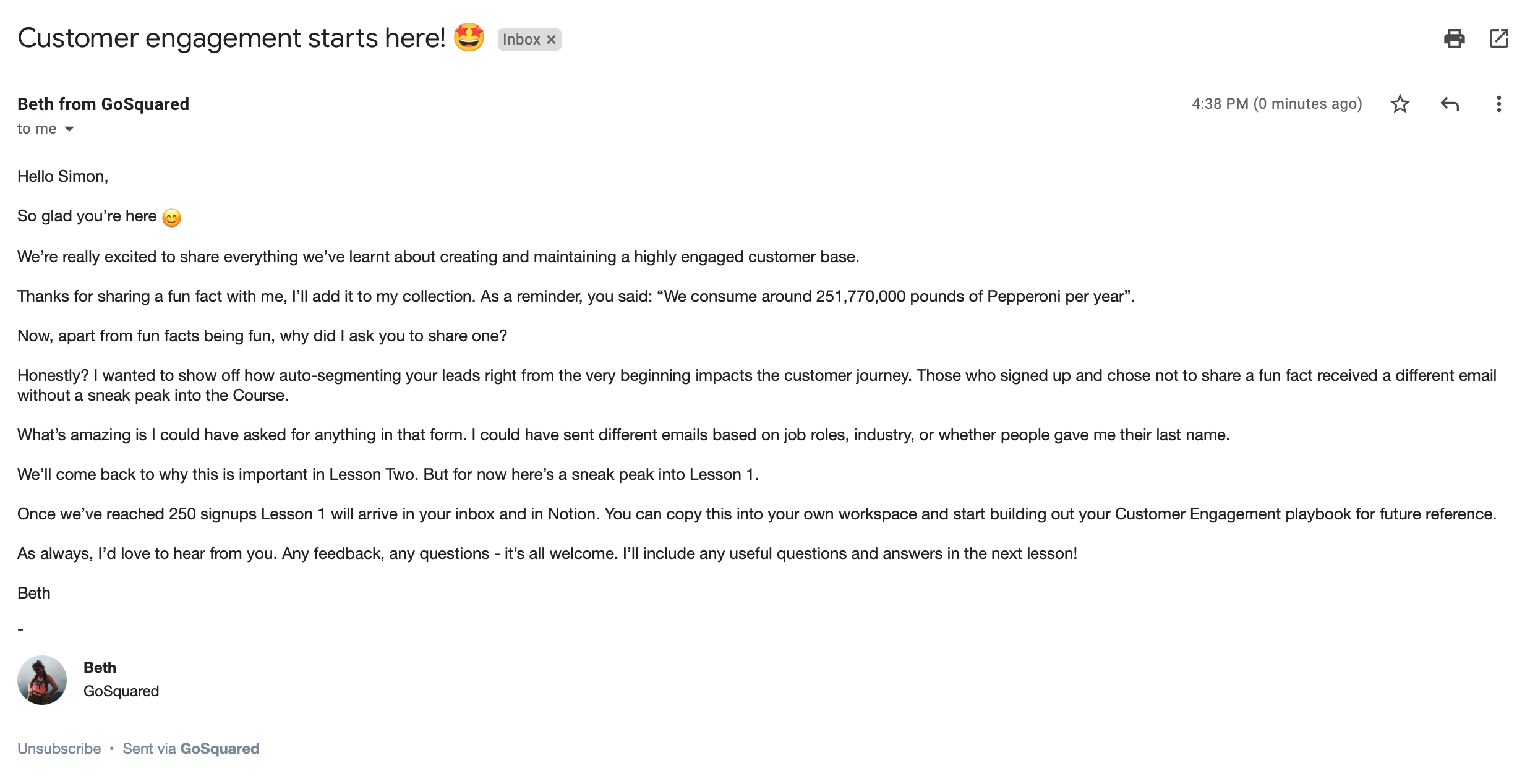We all want highly-engaged customers who value our products and stick around for as long as possible.
A huge amount of thinking, resources, and time goes into getting closer to our customers, tailoring campaigns and offers towards them, and making them feel valued. We’ve known the importance of personalisation for years, and by this point, most of us personalise our communications in some way.
We also know that onboarding is a big part of what makes customers successful. Good onboarding gets your customers set up properly, introduces them to the product, and starts fostering that ‘stickiness’ we’re all after.
Businesses that understand the value of experiential customer data start applying insights as soon as they can. They look at how customers moved through the onboarding phase, what features they activated, which emails they opened, and then tailor their communications from there.
What few businesses are doing (even those who really get it) is using this data right at the very beginning of the customer journey, at the first opportunity to create a longer-lasting, more engaged customer relationship.

Why would you build a personalised onboarding experience?
The first few days and weeks a customer is with you sets up how engaged your customer will be.
This is not an immovable level of engagement, but it is that customer’s baseline. Our research shows that customers tend to return to the same level of engagement that they showed during their onboarding phase (if your engagement strategy is doing its job of maintaining their interest and providing them with value).
Maintaining something takes a lot less energy and effort than building something from scratch.
This is to say that: if you start with low engagement, it’s always going to be an uphill climb. On the other hand, if you begin with highly-engaged customers, the job of keeping them at that level is far easier.
Starting out with a personal touch is a core way of setting that baseline level of engagement as high as you can.
Remember, though, your onboarding doesn’t end a set number of days after your customer joins you. Educating your customers on the best ways to use your product should be a long-term consideration of your Customer Engagement Strategy.
In SaaS onboarding, this is particularly important, as features are being updated and added (or taken away!) all the time which means the way you give value to your customers is constantly changing too. It’s this value you need to tap into, which means reviewing and editing your onboarding journey.

The first data point.
The very first time you interact with your customers is both important and underused. Getting off on the right foot builds trust, builds familiarity and lets your customers get to their ‘aha!’ moment faster.
To show off how powerful this first data point can be, I built it into the signup process of our Mastering Customer Engagement course.
In this case, I used an optional form field to segment the signups.

On the backend, this created two different Smart Groups: one for ‘Gave a Fun Fact’ and one for ‘Didn’t give a Fun Fact’.
I sent a different email to each group.

vs.

I could have asked for something (arguably) more useful than a Fun Fact here. Some great examples we’ve seen from customers include:
- Signups level of knowledge/experience with similar tools or the topic
- Team size / Expected other team members to use the platform
- The feature they’re most excited about / prioritising getting started with
- Whether they prefer to learn by reading, listening, watching, or being shown
You can see how this information would enable you to customise onboarding sequences right from the very beginning of the customer journey.
Setting goals for your onboarding.
As with all marketing, sales, and customer success projects, your onboarding strategy is going to be more successful if you set goals and are clear about the desired results.
It’s important that these goals aren’t just metrics but also factor in an understanding of the customer experience. What this means is that measuring a number without understanding its context renders the number useless.
You should set goals separately against each segment of your customer base. The onboarding you create for your freemium users is going to have a different cadence and outcome than your onboarding sequence for free trial users. They have different problems, different questions, and sit at different stages of the customer journey.

Key Activation Features
Every product has those magic features that customers come in for and stick around for. These are your Key Activation Features.
Which features they are might differ by your customer’s use case and stage in their journey. Understanding this (and putting it to work) can help to streamline your onboarding emails, making them more effective and less overwhelming.
We don’t recommend sending more than 2 types of communication per week to your customers. Sure, if you’re going to stretch this rule, the best time to do it is in the onboarding phase, but you still don’t want to overwhelm or annoy your customers – especially if the engagement with these emails is low.
You can identify your Key Activation Features by looking at the experiences of your best, most successful, happiest customers. (You might want to break this out by use case if your product has a broad remit.)
Which features do these customers use the most? Which do they find most helpful? Which features do they mention the most often, or speak about most animatedly? Which features do they use like a habit?
These are the features you want your new customers to set up first.
Why?
Well, your data says that people who use those features go on to become highly engaged, happy, long term customers. Setting up these key features should be the number one goal of your onboarding strategy.
Not only should these features play a huge role in your onboarding strategy, but Key Activation Features can help you prevent churn too.

Building smart sequences.
It’s unlikely that you have just one route your customers will take.
Mapping out the different customer journeys that some of your most successful customers have gone through is a great way to get the context of just how different these routes can be.
Smart Sequences are specifically tailored to the customer segment and goals you’ve set out in your onboarding strategy.
So, how do you build a personalised email onboarding sequence?
1. Know your customers:
- Gather information on your current onboarding strategy and its results.
- Interview your customers about their experience, their pain points and the features they value the most. Cross-reference this with real experience-based behavioural data.
2. Break up your segments, and set goals:
- Use the Key Activation Features framework and your understanding of customer behaviour to split your onboarding up.
- Keep it as simple as possible, and if ever in doubt, lead with the use case or value-added instead of features.
3. Pick your tools:
- You need to be able to track behavioural data, segment your users into groups, and trigger a range of messages such as one-shot emails, in-app notifications, and email sequences.
- GoSquared was built to do Customer Engagement like this, but there are a range of tools you can combine together.
4. Plan the journey:
- Always think in journeys, not broken up messages. Know where you want to get your customers to and work back from there.
- Try to limit your sequence to 5-6 emails and front-load your strategy with the most essential information.
- Think about it this way, if they stopped opening every email after this one, would they still get it?
5. Write and design your sequence:
- Once you have the order of your onboarding campaign in place, it’s time to start writing and designing.
- Go back to your customer interviews and pay attention to the exact words and phrases your customers say, and use these same words. This is called Language Market Fit, and it’s incredibly powerful.
6. Set a review date:
- You should be reviewing your onboarding on a regular basis; this can be done at the same time you check in on your Customer Engagement Strategy.
If you’re using GoSquared to build these sequences, you can get the playbook for building segmented onboarding sequences here. If you’d like to give GoSquared a go for free and see what you think, we’d be happy to help!
Don’t box yourself in.
Onboarding is one stage of a much broader system of Customer Engagement. Doing onboarding well is great, but our customer’s experience can’t only be great in isolation. It has to join up.
Understanding how to build an end-to-end Customer Engagement Strategy will make every single part of your customer journey more impactful.
Finally, remember that onboarding isn’t only about email. There are so many different ways to build a successful onboarding strategy that incorporates in-app messaging, email, 1-2-1 outreach, training calls, and community building. The most important thing is to figure out how your customers behave and what they’re looking for. Go to them, don’t make them come to you.

